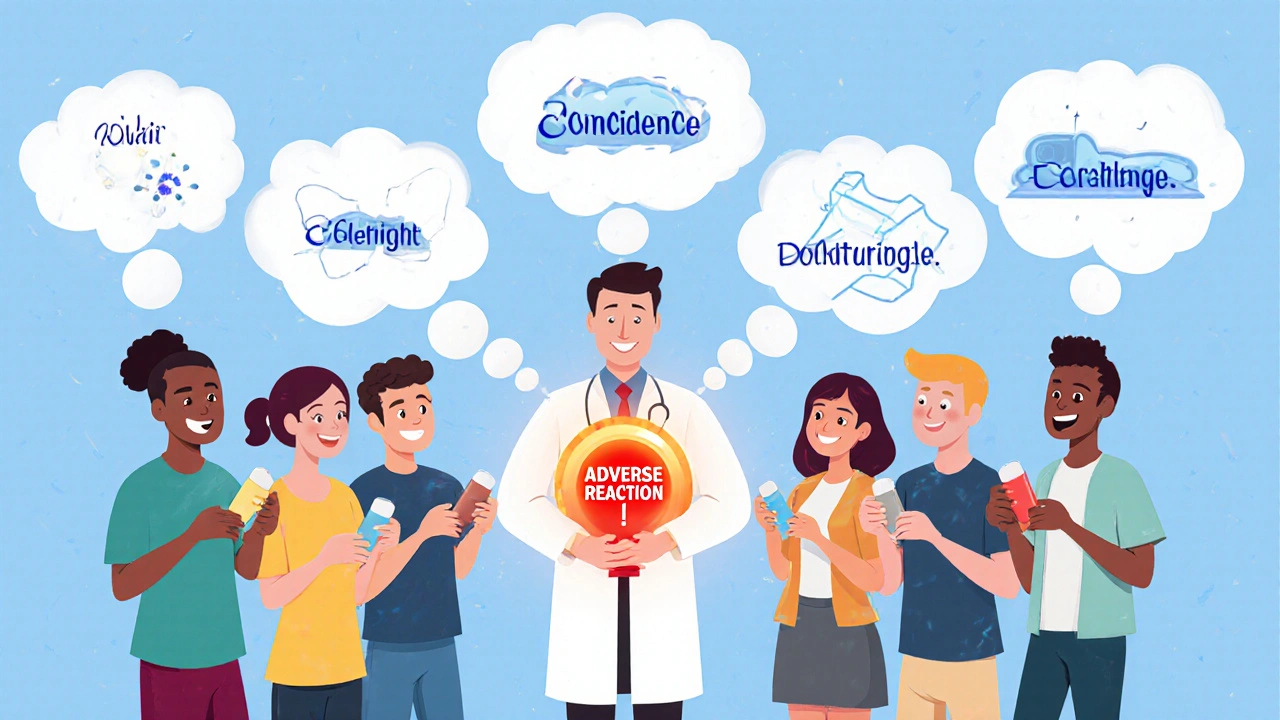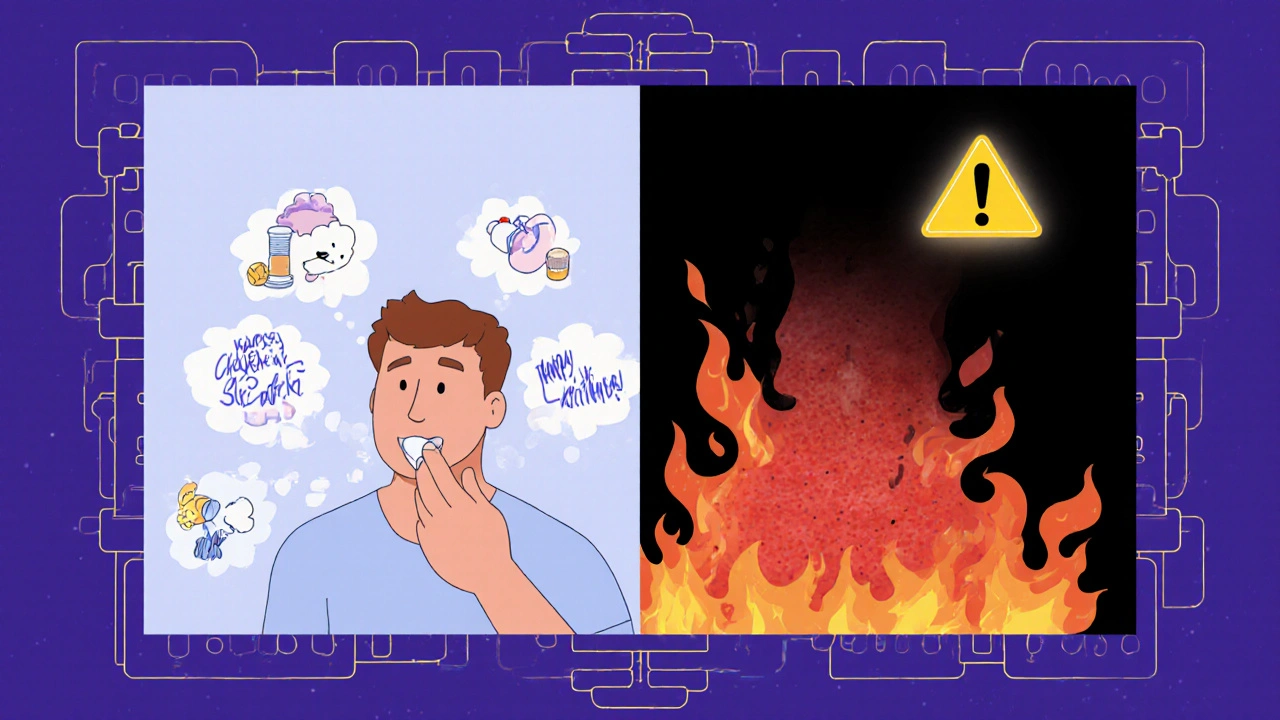When you take a pill, you expect it to help. But sometimes, something unexpected happens - a headache, nausea, dizziness. You might call it a side effect. And you’re not wrong. But here’s the thing: not every strange feeling after taking medicine is a side effect. Some are just bad luck. Others? They’re something more serious - and the difference matters more than you think.
What’s a Side Effect, Really?
A side effect is a predictable, known reaction to a drug that happens because of how the drug works in your body. It’s not a mistake. It’s not an accident. It’s built into the drug’s design.
Think of it like this: if you take ibuprofen to reduce pain, it also slows down the protective lining in your stomach. That’s why some people get heartburn or stomach upset. It’s not random. It’s direct. The same mechanism that reduces inflammation also irritates your gut. That’s a classic side effect.
These are the reactions doctors expect. They’re listed in the drug’s patient information leaflet. They’re often dose-dependent - the higher the dose, the more likely you’ll feel them. About 80-85% of all drug-related problems fall into this category. Examples include:
- Drowsiness from antihistamines
- Dry mouth from antidepressants
- Diarrhea from antibiotics
- Low blood pressure from blood pressure meds
Side effects show up in clinical trials. Researchers compare people who took the drug with those who took a placebo. If the symptom happens significantly more often in the drug group, it’s labeled a side effect. That’s how we know it’s real - and not just coincidence.
What’s an Adverse Drug Reaction?
An adverse drug reaction, or ADR, is a broader term. It includes side effects - but also things that are unpredictable, rare, and sometimes dangerous.
There are two main types:
- Type A (Augmented): These are the predictable ones - the side effects we just talked about. They’re dose-related and happen to many people. Think nausea from chemotherapy or low blood sugar from insulin.
- Type B (Bizarre): These are the curveballs. They’re not related to the drug’s main action. They’re rare. They’re often allergic. And they can be life-threatening.
Examples of Type B reactions:
- Anaphylaxis from penicillin
- Stevens-Johnson syndrome from sulfa drugs
- Severe liver damage from acetaminophen in sensitive individuals
These reactions don’t show up clearly in trials because they’re too rare. A drug might be tested on 10,000 people, and only one person gets a dangerous skin reaction. That’s why we only catch these after the drug hits the market - and why reporting them matters.
What’s an Adverse Event?
This is where confusion really kicks in.
An adverse event is any negative health occurrence that happens after you take a drug - no matter what. It doesn’t mean the drug caused it. It just means the two things happened around the same time.
Imagine you’re taking a blood pressure pill. One day, you fall and break your wrist. You didn’t faint. You weren’t dizzy. You just slipped on ice. That’s an adverse event - but it’s not caused by the drug. It’s just a coincidence.
Or you take a new antidepressant and develop a cold two days later. The cold wasn’t caused by the pill. But if you report it to your doctor, they’ll log it as an adverse event. Why? Because until proven otherwise, everything that happens after taking a drug gets flagged.
Adverse events are the raw data. Side effects and adverse drug reactions are what we discover after we sort through that data.

Why the Difference Matters
Here’s the real problem: people stop taking life-saving meds because they think every bad feeling is a side effect.
A 2021 study found that 43% of patients quit their prescriptions after mistaking unrelated events - like a stomach bug or a bad night’s sleep - for drug side effects. That’s dangerous. Stopping blood thinners, insulin, or heart meds without medical advice can kill.
Doctors and pharmacists need to know the difference too. If a nurse writes “side effect” in a chart when it’s really just an adverse event, it can lead to:
- Wrong dosing decisions
- Unnecessary drug switches
- Insurance claim denials
According to a 2023 study in the Journal of the American Medical Informatics Association, incorrect documentation contributes to 12% of medication-related insurance rejections. That’s not just bureaucracy - it’s a barrier to care.
And it’s not just patients. A 2021 survey by the Institute for Safe Medication Practices found that 68% of healthcare workers use “side effect” and “adverse reaction” interchangeably. That’s a huge problem when safety reports go to the FDA.
How Experts Tell Them Apart
It’s not guesswork. There’s a process.
At top hospitals like UCSF, staff use a 3-step method:
- Timing: Did the symptom start shortly after the drug was started? (Usually within hours to days.)
- Dechallenge: Did the symptom go away when the drug was stopped?
- Rechallenge: Did it come back when the drug was restarted? (Only done if safe.)
They also check databases like Micromedex to see if the symptom matches known drug profiles.
And then there’s the data. In a 2020 JAMA study of the blood thinner apixaban, researchers found:
- Headache: 12.3% in drug group, 11.8% in placebo → Not a side effect
- Major bleeding: 2.1% in drug group, 0.5% in placebo → Confirmed side effect
That’s how you know what’s real.
What’s Changing in 2025
The rules are getting stricter - and smarter.
The FDA now requires AI tools used in drug safety monitoring to clearly distinguish adverse events from confirmed reactions. By December 2025, every system must prove it can tell the difference.
Pharmaceutical companies are spending millions on software that uses machine learning to analyze millions of patient reports. One tool, validated in 2023, improved side effect identification accuracy by 41%.
And now, genetics play a role. A 2023 Nature Medicine study showed people with a certain gene variant (CYP2C19) are 8.7 times more likely to bleed from the blood thinner clopidogrel. That’s not a random side effect - it’s a genetic predisposition. Testing for it can prevent harm.
The World Health Organization’s latest drug dictionary now lists over 14,000 confirmed side effects - up from under 12,000 just three years ago. We’re getting better at knowing what’s real.

What You Should Do
If you’re on medication:
- Don’t assume every new symptom is from the drug.
- Track when symptoms start, how long they last, and what else changed in your life.
- Report anything unusual to your doctor - but be clear: say “I had this after starting the pill,” not “This is a side effect.”
- Ask: “Is this something this drug is known to cause?”
If you’re a caregiver or family member:
- Don’t let fear make someone quit their meds.
- Help them distinguish between a temporary upset stomach and a true allergic reaction.
- Keep a simple log: symptom, date, time, dose.
It’s not about being perfect. It’s about being precise. The right word can mean the difference between staying safe - and being in danger.
When to Seek Help
Call your doctor or go to the ER if you experience:
- Swelling of the face, lips, or throat
- Difficulty breathing
- Severe rash or blistering skin
- Unexplained bruising or bleeding
- Yellowing of skin or eyes
- Severe dizziness or fainting
These aren’t side effects. These are emergencies.
Are side effects and adverse reactions the same thing?
Not exactly. All side effects are adverse reactions, but not all adverse reactions are side effects. Side effects are predictable, dose-related, and directly tied to the drug’s action. Adverse reactions include those - plus rare, unpredictable, and sometimes allergic reactions that aren’t dose-dependent.
Can an adverse event be harmless?
Yes. An adverse event is just any negative health occurrence that happens after taking a drug - whether or not the drug caused it. A headache that happens to coincide with your new medication is an adverse event. If it’s not more common in people taking the drug than in those taking a placebo, it’s not a side effect. It’s just bad timing.
Why do drug labels list so many side effects?
Drug labels list all adverse events observed during clinical trials, even those later ruled out as side effects. This is required by regulators to ensure transparency. But many of the listed effects aren’t caused by the drug - they’re just reported during the study period. Always ask your pharmacist which ones are actually linked to the medication.
Can I report an adverse event myself?
Yes. In the U.S., you can report directly to the FDA through MedWatch (Form 3500). You don’t need a doctor’s note. Just describe what happened, when, and what drug you were taking. These reports help regulators spot new safety issues. Your report could help someone else avoid harm.
Do side effects mean the drug isn’t working?
No. Side effects are separate from effectiveness. You can have side effects and still be getting the full benefit. For example, many people on statins get muscle aches, but their cholesterol is still dropping. Don’t stop the drug unless your doctor says to - even if you have side effects.
Final Thought
Medicine isn’t magic. It’s chemistry. And chemistry has consequences. But those consequences aren’t all the same. Learning to tell the difference isn’t just for doctors - it’s for anyone who takes pills. The more you understand, the less you’ll fear. And the more likely you are to stay on the treatment that keeps you alive.


